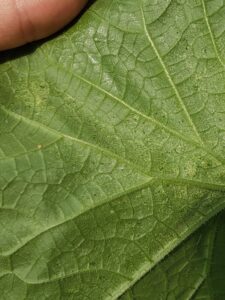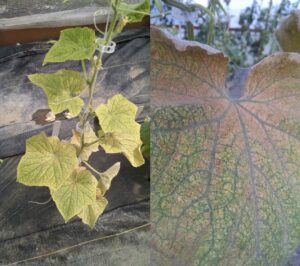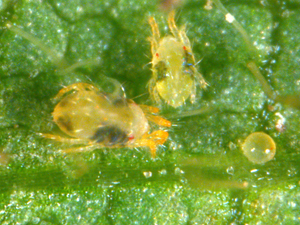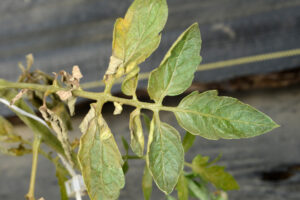While we might be struggling with the heat and lack of rain, there is one pest that is loving it, Mites! Now is the time to be on your toes watching out for this pest. Early detection and treatment are key. In protected environments prevention and early intervention are especially important; In the field, heavy rains can help knock these pests back.
Two-spotted spider mites (TSSM) are one of the most common mite pests on vegetables. TSSM occur throughout the world. They are known to feed on over 300 plant species, including tomatoes, cucumbers, melons, grapes, apples, and a variety of common flower and weed species. They disperse by walking or flying on the wind currents. The adults are a pale green to yellowish color, or almost appear translucent, with two black spots on their back. Eggs and nymphs are present and overlapping with adults. The eggs are very small yellowish or translucent circles and the nymphs are yellowish to green in color. Spots are not present until they are mature.
Early infestations can be spotted by scouting the leaves for the characteristic stippling that occurs as a result of mite feeding, then turn over the leaf to look for the pest or feeding damage resulting from the pest scraping the contents from the plant cells (Figure 1). As infestations build you will be able to spot the characteristic webbing that these mites build, leading to their name (Figure 2). TSSM can be found on the underside of leaves with a 10X hand lens (Figure 3).
Another species of mite that has been encountered in Indiana is the tomato russet mite. They are much smaller than TSSM, conical in shape and yellow to translucent in appearance. As the name suggests, this mite feeds on crops in the solanaceous family: tomato, potato, eggplant, pepper. Their damage leads to bronzing and curling of the leaves (Figure 4). Russet mites require a 14X hand lens at least to be viewed (Figure 5).
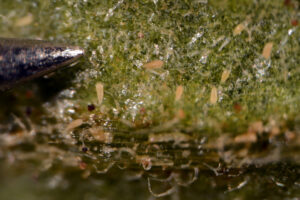
Figure 5. Close-up of tomato russet mites on the underside of a tomato leaf. Photo by John Obermeyer.
There are a variety of insecticides/miticides available to treat these pests such as those containing abamectin (Agri-Mek®), bifenthrin (Brigade®), spriomesifen (Oberon®), acequinocyl (Kanemite®), fenpyroximate (Portal®). When making any pesticide applications this time of year it is important to consider the impacts of the application on non-target organisms, such as predatory insects and pollinators. Some of the chemistries available have less impact on these beneficial insects. Choosing a chemistry that has fewer non-target impacts according to the labels, such as Portal®. Also, make applications as late in the day as possible, when the flowers have closed, and pollinators are less active. For more information on protecting pollinators in your fruit and vegetable crops read this publication of production practices and this one for commercial applicators.
